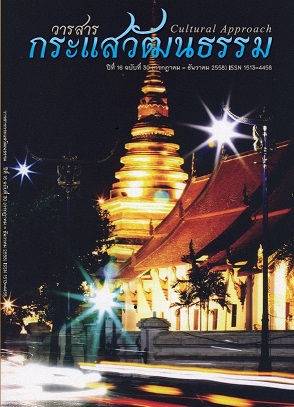The Comparison of Main Characters and Social Beliefs Between Thai Legend “Mae Nak Phra Khanong” and Chinese Legend “Madame White Snake”
Main Article Content
Abstract
The Thai legend “Mae-NakPhraKhanong”, which means: “Lady Nak of PhraKhanong” and The Chinese legend “Madame White Snake” are well-known as traditional legends. They are similar in story plots, main characters, and social beliefs. Therefore, the purpose of this paper is to compare and to summarize these two legends in the following issues; (1) The main characters between “Mae-Nak” and “BaiSuzhen”, “Po-mak” and “Xu Xian”, “SomdetBudhacariya (TohBrahmaransi)” and “Fahai” (2) social beliefs especially ghost and devil stories from these traditional legends. This article will offer benefits to Thai academics who conduct research related to this topic in the future.
Article Details
How to Cite
Phukwanpong, P. (2015). The Comparison of Main Characters and Social Beliefs Between Thai Legend “Mae Nak Phra Khanong” and Chinese Legend “Madame White Snake”. Journal of Cultural Approach, 16(30), 55–67. retrieved from https://so02.tci-thaijo.org/index.php/cultural_approach/article/view/58454
Section
Academic Article
Proposed Creative Commons Copyright Notices
1. Proposed Policy for Journals That Offer Open Access
Authors who publish with this journal agree to the following terms:
- Authors retain copyright and grant the journal right of first publication with the work simultaneously licensed under a Creative Commons Attribution License that allows others to share the work with an acknowledgement of the work's authorship and initial publication in this journal.
- Authors are able to enter into separate, additional contractual arrangements for the non-exclusive distribution of the journal's published version of the work (e.g., post it to an institutional repository or publish it in a book), with an acknowledgement of its initial publication in this journal.
- Authors are permitted and encouraged to post their work online (e.g., in institutional repositories or on their website) prior to and during the submission process, as it can lead to productive exchanges, as well as earlier and greater citation of published work (See The Effect of Open Access).
Proposed Policy for Journals That Offer Delayed Open Access
Authors who publish with this journal agree to the following terms:
- Authors retain copyright and grant the journal right of first publication, with the work [SPECIFY PERIOD OF TIME] after publication simultaneously licensed under a Creative Commons Attribution License that allows others to share the work with an acknowledgement of the work's authorship and initial publication in this journal.
- Authors are able to enter into separate, additional contractual arrangements for the non-exclusive distribution of the journal's published version of the work (e.g., post it to an institutional repository or publish it in a book), with an acknowledgement of its initial publication in this journal.
- Authors are permitted and encouraged to post their work online (e.g., in institutional repositories or on their website) prior to and during the submission process, as it can lead to productive exchanges, as well as earlier and greater citation of published work (See The Effect of Open Access).
References
[1] กลุ่มวัชราภรณ์. (2536). ประวัติและบารมีสมเด็จพระพุฒาจารย์(โต)พรหมรังสี วัดระฆังโฆสิตาราม(ธนบุรี). กรุงเทพ: วัชรินทร์การพิมพ์.
[2] ส.พลายน้อย. (2552). ตำนานผีไทย.พิมพ์ครั้งที่ 2. กรุงเทพ: สำนักพิมพ์พิมพ์คำ.
[3] สมภาร พรมทา. (2546). มนุษย์กับศาสนา. พิมพ์ครั้งที่ 1. กรุงเทพ: สำานักพิมพ์ศยาม.
[4] เสถียรโกเศศ-นาคะประทีป. (2515). เมืองสวรรค์และผีสางเทวดา. พระนคร: โรงพิมพ์พระจันท.
[5] เอนกนาวิกมูล. (2543). เปิดตำานานแม่นากพระโขนง. กรุงเทพฯ: สำนักพิมพ์โนรา
[6] 李耘. (2002).白蛇传故事嬗变研究. 首都师范大学
[7] 王蕾. (2014).白蛇传说”在影视作品中的改编. 湖南师范大学大学
[2] ส.พลายน้อย. (2552). ตำนานผีไทย.พิมพ์ครั้งที่ 2. กรุงเทพ: สำนักพิมพ์พิมพ์คำ.
[3] สมภาร พรมทา. (2546). มนุษย์กับศาสนา. พิมพ์ครั้งที่ 1. กรุงเทพ: สำานักพิมพ์ศยาม.
[4] เสถียรโกเศศ-นาคะประทีป. (2515). เมืองสวรรค์และผีสางเทวดา. พระนคร: โรงพิมพ์พระจันท.
[5] เอนกนาวิกมูล. (2543). เปิดตำานานแม่นากพระโขนง. กรุงเทพฯ: สำนักพิมพ์โนรา
[6] 李耘. (2002).白蛇传故事嬗变研究. 首都师范大学
[7] 王蕾. (2014).白蛇传说”在影视作品中的改编. 湖南师范大学大学


